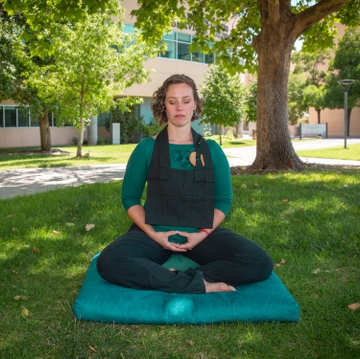Preparing for Disaster: UNM Hospital Participates in Region-Wide Emergency Training

Learning to be Present
Mindfulness Training Finds a Place in UNM's School of Medicine
Fifteen third-year medical students have come together at noon in a windowless conference room in the UNM Department of Surgery offices, helping themselves to sandwich wraps, chips and cookies while discussing the benefits of mindfulness.
Rebecca Williams-Karnesky, MD, PhD, a senior resident in General Surgery, leads the conversation. "Have any of you been using the breathing exercises that we've talked about?" she asks.
A student raises her hand. "Yeah, I did it yesterday," she says, describing a pressure-filled encounter with a surgeon who put her on the spot by asking her to describe the layers of the abdominal wall.
"I will think something, but not say the right thing," the student admits, "so I just paused and did the belly breathing thing." Having calmed herself, she provided the right answer. "It helps you catch up your words to your brain."
Williams-Karnesky nods approvingly as another student relates how he used his breathing to quell panicky feelings during a five-hour procedure in a too-warm room that lacked air conditioning.
A working definition of mindfulness flashes up on the screen at the front of the room: "Paying attention in a particular way, on purpose, in the present moment, non-judgmentally."
This is a theme that Williams-Karnesky returns to repeatedly in the mindfulness course, which unfolds in three one-hour sessions. It is mandatory for all third-years as they rotate through their surgical clerkships, drawing on a growing body of research suggesting that mindfulness can mitigate the risk of physician burnout.
She leads students through a variety of meditative techniques, including slow, steady abdominal breathing, which activates the body's relaxing parasympathetic response, mindful body scans and lovingkindness meditation, a practice shown to promote compassion.
"So much of medicine is about self-sacrifice for others," she says. "I spend one of the three sessions talking about compassion - and also self-compassion. We forget that we tell ourselves that we're superhuman and these things don't affect us, but they do, very deeply."
Williams-Karnesky brings unique credentials to her teaching role. When she started her MD/PhD program at Oregon Health & Science University in Portland, a nascent interest in meditation led her to visit the Dharma Rain Zen Center, which was located just two blocks from where she was living. "I was just like, 'This is it, I'm home.'"
Before long, she was living at the Zen center and joining in daily group meditation.
Dedicated training - including intensive seven-day meditation retreats called sesshin - enabled Williams-Karnesky to manage the stress of medical school and helped her to clarify why she wanted to become a physician in the first place.
"I decided when I was 5 I was going to be a doctor," she says. Through her Zen practice, she found herself asking, "Why am I doing this? How much is my ego wrapped up in this, and how do I take my ego out of it? How do I tap into that motivation of compassion?"
As she started to take more of a hand in patient care, she also found it was "very helpful in facing those challenging experiences in the clinical context, of feeling helpless or overwhelmed."
While in Portland, Williams-Karnesky taught meditation classes to youngsters in the Zen center's family program. When she came to UNM for her surgical residency, she approached John Russell, MD, chair of the Department of Surgery, about offering a mindfulness course for medical students.
"Dr. Russell is very supportive," she says. "From the time I said I wanted to do this, he said, 'Great!'" He also paid to buy the students copies of "The Mindful Medical Student: A Psychiatrist's Guide to Staying Who You Are While Becoming Who You Want to Be."
Third-year medical school students seem to be especially receptive to what the course has to offer, Williams-Karnesky says.
"When they hit third year, I think they start to recognize how difficult the clinical part is," she says. "They see those challenges of working with patients and their hours are much worse. They're integrating knowledge and practical experience, and doing that emotional work. It becomes much more relevant."
Williams-Karnesky shares her own experience as a resident to highlight ways in which mindfulness can be put to practical use. One example is the need to carry a pager (or two or three) while on call, and how an alert elicits a "Pavlovian" response of "instant frustration, anxiety and anger." The trick, she says, is to find the space between stimulus and response.
"My pager goes off, and I feel tightness in my chest, I feel angry," she says. "But with mindfulness I'm able to feel that and allow it. I take a breath, relax and pick up the phone and say, 'How can I help you?'"
Mindfulness also offers an alternative for those times when a physician has done all she can for her patient - and it's still not enough. "A lot of times, it's just being present to that person," Williams-Karnesky says.
She has received national recognition for work, including the Resident Teaching Award at the Association of Surgical Residents meeting in Chicago, and an invitation to present at the 2019 American College of Surgeons Clinical Congress.
Williams-Karnesky also has joined the School of Medicine's newly created Learning Environment Office as a research fellow,
Thanks to a growing awareness of the dangers of burnout, medical students now start learning about the importance of physician wellness early in their training. "Wellness is certainly on the radar," she says.
"Figuring out what works for wellness for surgeons, what parts are institution-driven, what are personal factors - that's certainly been part of the conversation."